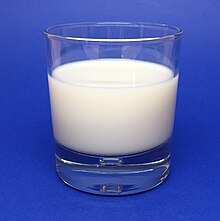| Milk-alkali syndrome | |
|---|---|
| Other names | Calcium-alkali syndrome[1] |
 | |
| Symptoms | Vertigo, confusion, apathy, nausea and vomiting, anorexia, tremors, psychosis, myalgia, polyuria, renal calcifications, and pruritus. |
| Complications | Renal failure, death. |
| Causes | Intake of large amounts of calcium and absorbable alkali. |
| Risk factors | Older age; acute and chronic renal failure; bulimia nervosa; use of certain drugs such as thiazide, NSAIDs, and ACE inhibitors. |
| Diagnostic method | Based on physical symptoms, laboratory findings, ECG, and X-ray (to exclude other causes of hypercalcemia). |
| Differential diagnosis | Other disorders that can cause hypercalcemia such as: hyperparathyroidism, malignancies, hyperthyroidism, sarcoidosis, and other malignancies. |
| Prevention | Decrease calcium intake (1.2-1.5 g/daily for individuals with risk factors for MAS). |
| Treatment | Withdrawal of the offending agent, hydration, hemodialysis (in extreme cases). |
Milk-alkali syndrome (MAS), also referred to as calcium-alkali syndrome, is the third most common cause of elevated blood calcium levels (hypercalcemia).[2][3] Milk-alkali syndrome is characterized by hypercalcemia, metabolic alkalosis, and acute kidney injury.[4]
Milk-alkali syndrome can be caused by the excessive intake of calcium and absorbable alkali. Sources of calcium and alkali include dietary supplements taken for the prevention of osteoporosis or hyperparathyroidism and antacids taken for peptic ulcer disease.[5] Common acute symptoms of milk-alkali syndrome include nausea and vomiting, dry mouth, confusion, lethargy, and distaste for milk.[3][4][6] If left untreated, milk-alkali syndrome may lead to kidney failure or even death.[5][7]
- ^ "Milk-alkali syndrome: MedlinePlus Medical Encyclopedia". medlineplus.gov. Retrieved 16 April 2019.
- ^ Picolos, Michalis K.; Lavis, Victor R.; Orlander, Philip R. (2005). "Milk–alkali syndrome is a major cause of hypercalcaemia among non-end-stage renal disease (non-ESRD) inpatients". Clinical Endocrinology. 63 (5): 566–576. doi:10.1111/j.1365-2265.2005.02383.x. ISSN 1365-2265. PMID 16268810. S2CID 26770851.
- ^ a b Cite error: The named reference
Medarov2was invoked but never defined (see the help page). - ^ a b Cite error: The named reference
:0was invoked but never defined (see the help page). - ^ a b Ali, Rimsha; Patel, Chinmay (2021), "Milk-Alkali Syndrome", StatPearls, Treasure Island (FL): StatPearls Publishing, PMID 32491432, retrieved 2021-08-04
- ^ Cite error: The named reference
:1was invoked but never defined (see the help page). - ^ Irtiza-Ali, Ayesha; Waldek, Stephen; Lamerton, Elizabeth; Pennell, Ashley; Kalra, Philip A. (2008). "MILK ALKALI SYNDROME ASSOCIATED WITH EXCESSIVE INGESTION OF RENNIE®: CASE REPORTS". Journal of Renal Care. 34 (2): 64–67. doi:10.1111/j.1755-6686.2008.00018.x. ISSN 1755-6678. PMID 18498570.